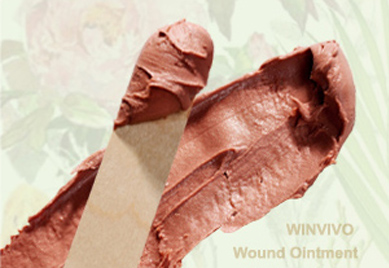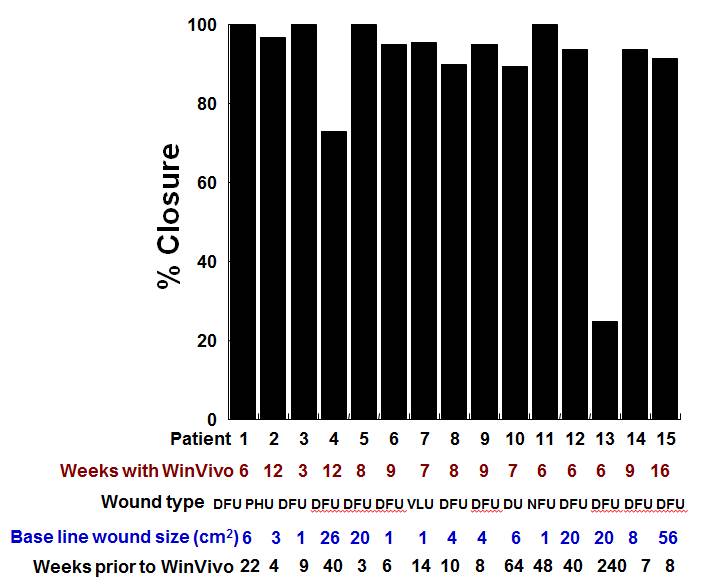Arterial Ulcers
 Peripheral artery disease (PAD), the circulatory disease commonly associated with non-healing wounds, affects about 8 -12 million Americans. One in 3 people age 70 or older has PAD. It is known by many names - peripheral arterial disease (PAD), peripheral vascular disease (PVD), lower extremity arterial occlusive disease, leg atherosclerosis or leg artery disease.
Peripheral artery disease (PAD), the circulatory disease commonly associated with non-healing wounds, affects about 8 -12 million Americans. One in 3 people age 70 or older has PAD. It is known by many names - peripheral arterial disease (PAD), peripheral vascular disease (PVD), lower extremity arterial occlusive disease, leg atherosclerosis or leg artery disease.
Worldwide, aging of the population and increase in diabetes rates correlate with the increase in the number of patients with PAD. The majority of leg ulcers are associated with circulation problems: poor venous blood return in the veins causes venous ulcers (~70% of ulcers), and poor arterial blood supply to the legs arterial ulcers (~25% of ulcers).
Arterial ulcers, also referred to as ischemic ulcers, are caused by poor perfusion (delivery of nutrient-rich blood) to the lower extremities. Arteries are responsible for carrying nutrient- and oxygen-rich blood to the various tissues in the body. Arteries can slowly become narrowed and blocked as a consequence of age, smoking, high blood cholesterol or diabetes. Less blood reaching the muscles in the legs makes them hurt, like angina makes the heart muscle hurt. Other than pain, the most common symptoms of PAD are cramping or tiredness in the leg or hip muscles while walking or climbing stairs. Typically, this pain goes away with rest and returns when you walk again. Such arterial pain is described as claudication or rest pain. Over time, the reduced blood flow leads to tissue ischemia (causing the “blue toe syndrome” for example), tissue death or necrosis (gangrene), and/or ulceration.
In addition, the lack of blood supply can result in minor scrapes or cuts failing to heal and eventually developing into ulcers.
The arterial ulcer has a punched-out look, with well-defined, even wound margins. Arterial ulcers are often found between or on the tips of the toes, on the outer ankle, or where there is pressure from walking or footwear. The wounds are usually deep, often extending down to the underlying tendons, and frequently have no signs of new tissue growth. The base of the wound typically does not bleed, and is yellow, brown, grey or black in color.
Often the limb feels cool or cold to the touch, and has weak to absent pulse. The skin may appear shiny, thin, dry and tight with loss of hair. These ulcers are generally very painful, especially while exercising or during the night
Treatment of Arterial Ulcers
People with PAD are three times more likely to die of heart attacks or strokes than those without PAD. The goals in treating patients with ischemic ulcers are: reducing cardiovascular risk factors, relieving ischemic pain, healing ulcers, preventing major amputation, preservation of mobility, improving quality of life and increasing survival.
If your disease has advanced, your physician may recommend surgical or minimally invasive treatments. The choice of the treatment depends upon the pattern and extent of the blockages as well as other factors, such as your general health and the presence of other medical conditions.
The surgical options are:
- Angioplasty and stent placement of the peripheral arteries (to open up the blood vessels of the affected leg)
- Peripheral artery bypass surgery of the leg (to direct blood flow around the blocked area of the artery)
Medical therapy includes administration of analgesics, local wound care and pressure relief, treatment of infection, and aggressive therapy to modify atherosclerotic risk factors such as quitting smoking, keeping blood pressure, blood sugar, blood cholesterol and triglyceride levels under control, and losing weight if overweight.
Arterial leg ulcers are difficult to heal due to many complex issues, including:
- Poor blood circulation (ischemia)
- Disrupted epidermal barrier and susceptibility to infection
- Necrotic tissue hard to be removed without harming viable tissue
- Eschar and fibrous tissue formation
- Infection with antibiotic-resistant biofilms
- Prolonged inflammation
- Sometimes swelling (edema)
- Pain (especially at night)
- Patient’s resistance to life style modification (e.g., quit smoking, adopt a healthy diet and exercise regimen, and maintain a healthy weight)
Facing these challenges and to improve the speed and quality of healing, one may consider using a multi-functional botanical therapy with these features:
- Including botanicals with broad-spectrum anti-microbial properties to protect wound bed from infection and to inhibit formation and growth of bacterial biofilms without harming nascent, delicate regenerating tissue;
- Employing naturally anti-inflammatory and analgesic botanicals to suppress prolonged inflammation and pain;
- Combination with botanicals that promote microcirculation of the low extremities to facilitate autolytic debridement of necrotic tissue and to promote tissue regeneration;
- Ability to absorb wound fluid (exudate) and reduce malodor, and yet maintain a physiologically moist wound healing environment without causing maceration
- Allowing painless and less frequent dressing change;
- Healing wounds fast and effectively with maximum restoration of skin function and minimal scarring to reduce the chance of recurrence.
Related Product
WINVIVO Wound Ointment
 This is a uniquely-effective, multi-functional botanical ointment clincally proven to accelerate healing of challenging wounds and skin ulcers. Its unique paste formulation includes naturally antimicrobial, anti-inflammatory and analgesic botanicals to inhibit infection, suppress itching and pain, promote microcirculation and tissue generation.
This is a uniquely-effective, multi-functional botanical ointment clincally proven to accelerate healing of challenging wounds and skin ulcers. Its unique paste formulation includes naturally antimicrobial, anti-inflammatory and analgesic botanicals to inhibit infection, suppress itching and pain, promote microcirculation and tissue generation.
Botanicals in WINVIVO Wound Ointment
Borneol resin (Dryobalanops aromatica)
Borneol resin has been shown to be antibiotic having an inhibitory effect against Staphylococcus aureus, Diplococcus pneumonia, E. coli, Pseudomonas aeruginosa, and other dermatophytes. It has been used to treat dizziness, otitis, and various forms of abscesses and swellings.
 Camellia Oil or Tea Seed Oil (Camellia oleifera)
Camellia Oil or Tea Seed Oil (Camellia oleifera)
Composed mainly of Oleic acid (almost 82%, the highest among all natural oils), camellia oil is the most penetrative of all natural oils, capable of permeating deeply into the lower layers of the skin to greatly enhance the beneficial effects of our natural collagen and elastin.
Coptis root (Coptis chinensis Franch.)
 The dried rhizome of Coptis chinensis Franch is used in the preparation of the Healing Balm. Traditional Uses of Coptis Root The first record for medical use of coptis has been appeared in the Chinese medical literature of The Divine Farmer’s Materia Medica (25 A.D. to 220 A.D).
The dried rhizome of Coptis chinensis Franch is used in the preparation of the Healing Balm. Traditional Uses of Coptis Root The first record for medical use of coptis has been appeared in the Chinese medical literature of The Divine Farmer’s Materia Medica (25 A.D. to 220 A.D).
Corydalis tuber (Corydalis turtschaninovii)
 Corydalis tubers have been shown to be analgesic, sedative and tranquilizing but has not been shown to cause dependence, and to be anti-inflammatory in inhibiting histamine release and formation of edema in animals in both acute and chronic phases of inflammation.
Corydalis tubers have been shown to be analgesic, sedative and tranquilizing but has not been shown to cause dependence, and to be anti-inflammatory in inhibiting histamine release and formation of edema in animals in both acute and chronic phases of inflammation.
Dragon's Blood resin (Daemonorops draco)
 Traditionally, Dragon's Blood resin has been used externally to stop bleeding, promote generation of flesh, and contain ulceration in the treatment of traumatic injuries, non-healing ulcers and hemorrhoids with swelling and pain.
Traditionally, Dragon's Blood resin has been used externally to stop bleeding, promote generation of flesh, and contain ulceration in the treatment of traumatic injuries, non-healing ulcers and hemorrhoids with swelling and pain.
Fritillaria (Fritillaria cirrhosa)
 For thousands of years fritillaria has been used in Asia to clear heat and to moisten the lung dryness, for heat-type bronchitis with dry cough and for the heart (to calm heart fire). Fritillaria is also used for treating lumps beneath the skin, such as scrofulous swellings and breast lumps.
For thousands of years fritillaria has been used in Asia to clear heat and to moisten the lung dryness, for heat-type bronchitis with dry cough and for the heart (to calm heart fire). Fritillaria is also used for treating lumps beneath the skin, such as scrofulous swellings and breast lumps.
Lithospermum root (Lithospermum erythrorhizon)
 In modern reserach, lithospermum root has marked anti-inflammatory effects and promotes healing. It has been used clinically to treat psoriasis, burns, cervical erosion, and hepatitis.
In modern reserach, lithospermum root has marked anti-inflammatory effects and promotes healing. It has been used clinically to treat psoriasis, burns, cervical erosion, and hepatitis.
Rhubarb root (Rheum palmatum)
 In traditional Chinese Medicine, rhubarb is used extensively as a purgative to treat a wide variety of accumulations, including constipation caused by excess heat, epigastric distention, fullness.
In traditional Chinese Medicine, rhubarb is used extensively as a purgative to treat a wide variety of accumulations, including constipation caused by excess heat, epigastric distention, fullness.
Tree peony bark (Paeonia suffruticosa Andr.)
 This botanical is used for clearing heat and cools blood, invigorating blood circulation and dispersing blood stasis in traditional Chinese Medicine.
This botanical is used for clearing heat and cools blood, invigorating blood circulation and dispersing blood stasis in traditional Chinese Medicine.
Note:
Please be advised that the information presented above is not to be used as a substitute for medical advice, diagnosis or treatment of any disease. Statements made about products have not been evaluated by the Food and Drug Administration. Viewers should not rely solely on the information provided on this web site for their own health problems, and are advised to consult with their physicians or other healthcare providers.
User Experience
- Girlfriend Set Me Straight
~ Pamela W.
- I am very into natural remedies
~ Alex H.
- Headache Gone Overnight
~ Josh L.
- Blocked sickness on the way
~ Jeff C.
Related FAQs
WINVIVO Wound Ointment:
Multi-Functional Botanical Therapy
- Difficult-to-Heal Wounds
Clinical Case Reports
- Diabetic Foot Ulcers
- Venous Leg Ulcers
- Skin Ulcers of Mixed Etiology
- Pressure Ulcers/Bedsores
- Surgical Wounds
- Traumatic Wounds


Privacy Policy | Disclaimer | Knowledge Garden Disclaimer | Return Policy | Contact Us | Affiliate Program
© 2009-2013 WinVivo Corporation All Rights Reserved






